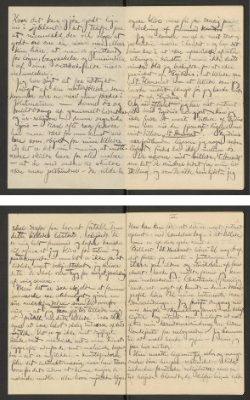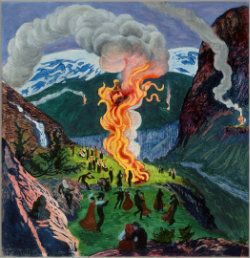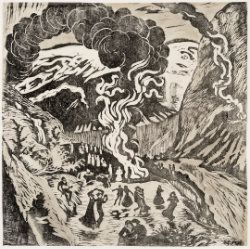
The Bonfires
Letter from Nikolai Astrup to Edvard Waldemar Aslaksen, October 10, 1908.
Dear Mr. Aslaksen!
At the same time that I thank You for the kindness You showed me by lending me the little sketch which You had purchased from me, I dare ask You to pardon me for permitting myself to write to You despite the fact that You are not personally acquainted with me.
I have long had the urge to write to You to thank You for the cordial letter You sent me this past spring, when I was in London. It has done me good to read through Your letter on many occasions, when I have been sick and tired of everything related to “art”. When I have thought of “giving up” – it has been a great comfort knowing, that there actually exist persons, to whom one has been able to bring pleasure through one’s art.
How salutary it is even unto one’s soul to encounter an individual, who is wiling to speak kindly of one, when one normally only experiences being the object of lies, slander and envy on the part of one’s spiteful fellow humans beings.
I have attempted to express something of the sense of nature that overwhelms one when wandering about in Jølster’s landscape – these vapours and damp soil saturated with age-old paganism and prehistoric religions – this soil full of legend – these predominantly raw colours have more value for my art than merely as subjects for my pictures. And that in my opinion, is what motifs should include when it comes to every painter – in other words, they should be more rooted in the land – then they would also be less marked by negative influences from foreign art.
I am perhaps one of the painters in this country who is most rooted in place and the land – and have staked my reputation on remaining unaffected by the many art movements – but despite this I am accused of being influenced by [Halfdan] Egedius in a picture like “Midsummer Eve” – a picture that I had painted long before I had seen anything by Egedius.
And now after I have seen almost everything that Egidiùs has done, I cannot find one single picture by Egedius that has the remotest resemblance to my “Midsummer Eve”. Egedius was attached to the soil like myself, no other resemblance exists between us.
You mention my picture “Midsummer Eve” as one You remember best from my exhibition, and which You would have liked to buy – I will therefore permit myself to tell You the history of this picture, even though You are a complete stranger to me and may therefore think, that I am being intimate and intrusive – but it is not in order to initiate any acquaintanceship that I write this. You can be assured that you will remain free of any “[clinging]” on my part later on. But it is so seldom a stranger openly gives one their recognition as You do to me – that I dare permit myself to talk about this picture – especially as You seem to have had a particular interest in its mystique. It is not my most accomplished picture in a purely painterly sense – but art often lies beyond the painterly concepts – it is the mystique the art lover instinctively feels, when he stands before it without being able to point to the painterly means – or what the mystique consists of.
He can only sense that something has been intimately experienced – backed by events – in a picture that is good art.
The picture Midsummer Eve is among the first that I painted – The young girl staring at the fire and most of the landscape I had painted before I enrolled in the painting school in Christiania (Oslo), before I had seen any art – This profile of a child belongs to my most intense childhood memories. – I attempted back then with my simple house paint colours as truthfully, naturally and intensely as possible to paint from my childhood memory a little peasant girl from the neighbouring farm. I will paint her again – if I live long enough.
Like myself and many other children here in West Norway, she was obliged to suffer under the religious fanaticism that raged among the elders here for a period, – everything was a sin – (even sledding.)
And on Midsummer Eve when the bonfires blazed throughout the mountains and the people swarmed like blacks dots up the sides of the mountains, and the girls dressed in red with white shirt sleeves formed rings of bright dots and sparks around the flares – it was a sin for Christian folks to join in – so the little girl and I had to stand at a distance behind the fence and watch and listen to how the others danced around the bonfire and shouted in joyful appreciation of nature – the last remains of an ancient religion that unconsciously flared up; – I had the impression that this bonfire was something sinful, ugly being carried out in the shadowy green semi-darkness – something pagan – and this was strengthened even more by the envy that dug into my breast – when the other children were allowed to join in, and I had to stand on the outside.
And that is how I perceived my little fellow sufferer and the ugly yellow fire, that did not light up the summer night; but which nevertheless lured and drew me to it, precisely because it was surrounded by mystique, wickedness and raw paganism – And in the end I dared wander about among the sinners, but the little girl stayed behind and watched with a pale countenance and the large black eyes that sucked in the fire; – and that is how the picture was originally imprinted in me. –
I would not have remembered anything of this image, if something had not happened to me later which refreshed my memory. –
Early one morning in late autumn the message was sent around to all the farms – people were called up to the mountains to participate in a search – my little girl had disappeared.
All day long the mountain was teeming with people searching. In the evening everyone descended towards the lake, and while we were resting on the ground right above the lake and sat looking out over it, we caught sight of something pale far out on a steep underwater incline, where we could no longer see the bottom. – I took one of the farm boys with me out in a boat – yes it was her – she had drowned herself; because it was shallow all the way out to where she lay. I dove down to the bottom – it was at a great depth and large eerie stones surrounded her, which she clung to – I pulled her loose, and while rising up through the water holding her, I could see her large black eyes, staring at me – that is when I remembered Midsummer Eve.
My first pictures I painted with ordinary house paint colours and one of the first attempts occurred on Midsummer Eve and so I attempted to paint this little girl and the bonfire, the landscape I touched up a little afterwards, when I had got hold of better paints; but the bonfire, the young girl and the fence remain as they were back when I painted it. I never dared to touch it since.
[…]
As I once again ask You to pardon my long letter, I am most gratefully obliged to You
Nikolai Astrup
Adr: Ålhus – Jølster – Sunnfjord

Letter from Nikolai Astrup to Edvard Waldemar Aslaksen, October 10, 1908

Nikolai Astrup, St. Hansbål, mellom 1904 og 1927, fargetresnitt med håndkolorering på papir, 356 x 348 mm. Sparebankstiftelsen DNB, KODE.

Nikolai Astrup, St. Hansbål, mellom 1904 og 1927, tresnitt på papir, 334 x 340 mm. Sparebankstiftelsen DNB, KODE.